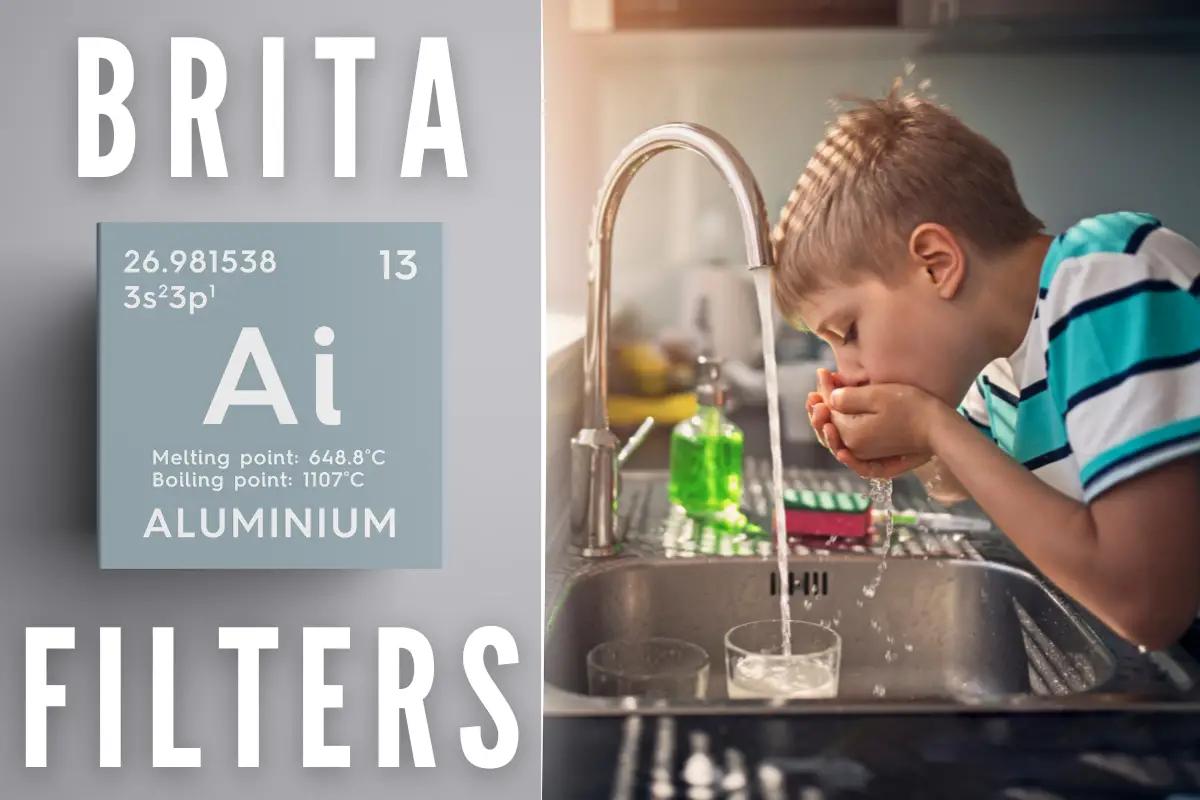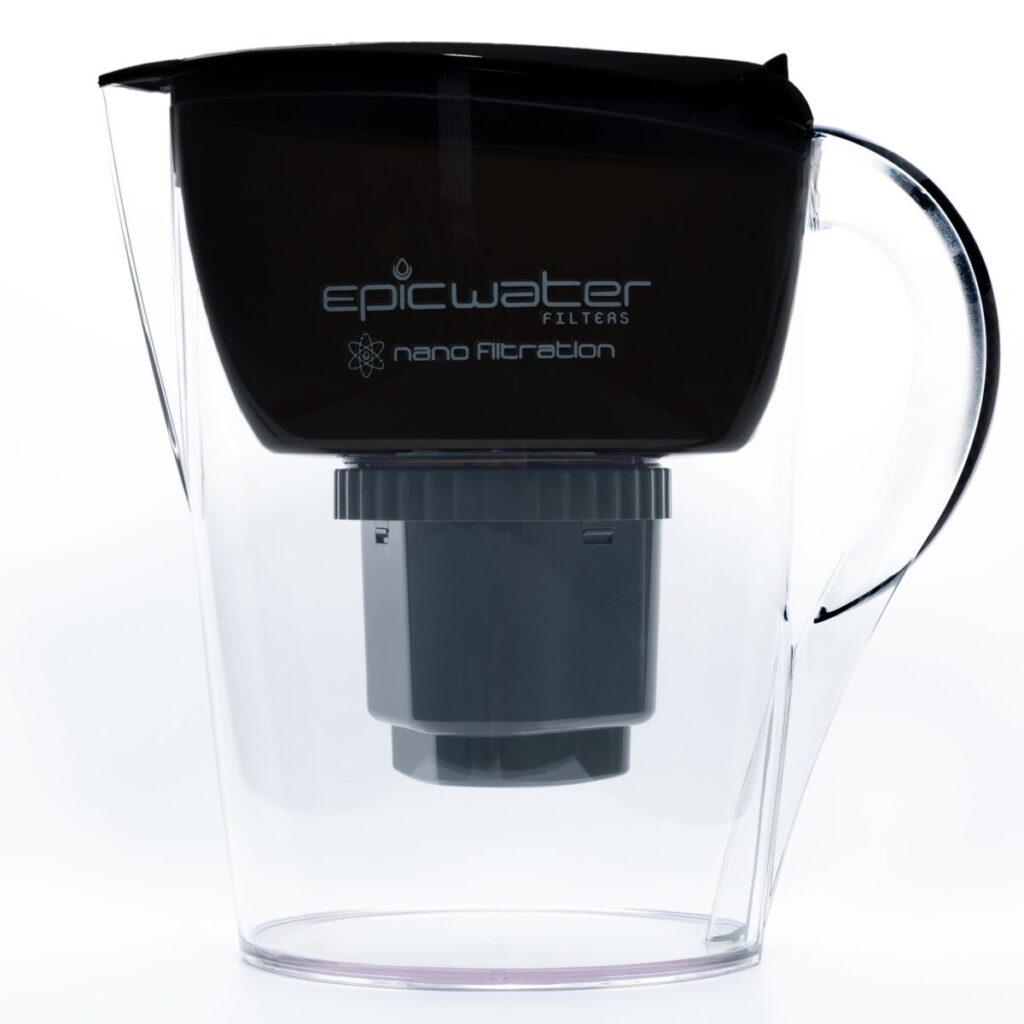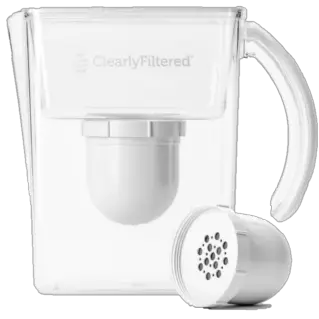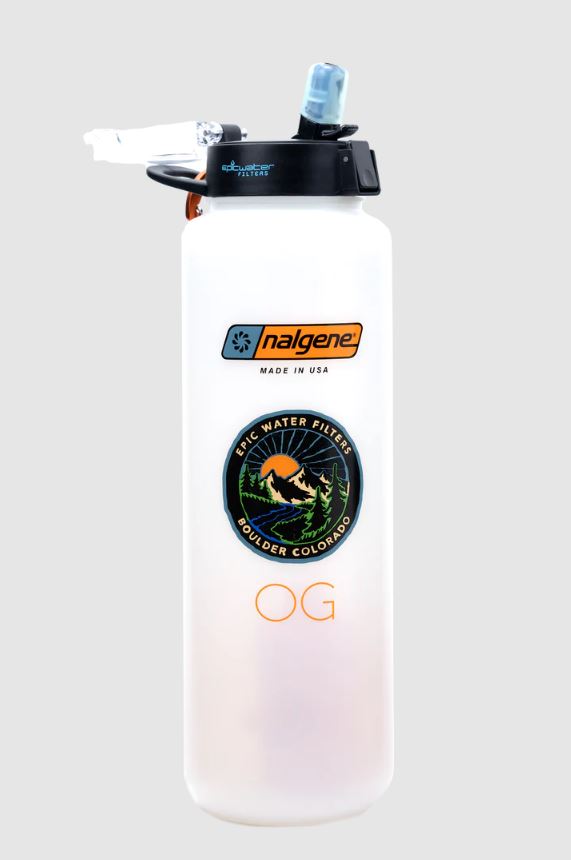Brita filters have long earned a permanent spot on many kitchen countertops. But Brita’s capabilities at reducing or removing aluminum, a common contaminant in drinking water, is of particular concern for some users.
Brita water filters do not remove aluminum and Brita make no claim any of their filters can.
Brita filters can still be a valuable addition to enhance your water’s taste and quality. In this post I’ll explain what metals Brita filters can remove, and provide you with three water filter brands that can remove or reduce aluminum from drinking water. I’ll also explain where the aluminum in drinking water comes from, the acceptable aluminum levels for drinking water, how to test for it, and the health effects of drinking it.
What is Aluminum?
Aluminum is the second most abundant metal element in the earth’s crust. Aluminum in nature is rarely found in its pure form that you and I would recognize as the silvery-white to dull-grey metal.
Aluminum combines with other elements to form different oxides or silicates, which are easily transported in water as dissolved, but mainly particulate, forms.
Do Brita Filters Remove Aluminum?

Brita make many different types of water filters that are sold all across the world, including:
- Standard
- Elite (also branded as the Longlast+)
- Longlast
- Faucet
- Stream
- Bottle
- MAXTRA+ (commonly sold outside of the United States, but can still be bought on Amazon.com)
- MicroDisc (commonly sold outside of the United States, but can still be bought on Amazon.com)
Brita water filters do not remove aluminum and Brita make no claim any of their filters can.
Despite this, Brita filters can remove other metals:
Metals That Brita Filters CAN Remove
Some Brita water filters have been tested under NSF standards 53, which showed they are able to reduce certain metals (not including aluminum).
The Standard, Elite, and Longlast Brita filters reduced metals including lead, mercury, and cadmium. The Faucet filter by Brita only removed lead.

Overall, there is no major difference between the type of Brita filter and its ability to remove lead, mercury or cadmium from water.
The only exceptions include:
- The Brita faucet filter removes approximately 0.2% less than the standard, elite and longlast filters – which is really no difference at all.
- The Longlast Brita filter reduces slightly more cadmium (0.5% at pH 6.5) than the standard or elite filters.
- Note the Longlast is the old Brita filter that was upgraded to the longlast+ filter (which is now branded as the elite) – confusing I know!
The Brita Stream, Bottle, and MicroDisc filters do not remove any metals from water.
The Maxtra+ Brita filters claims to reduce some metals such as lead and mercury but do not make it very clear by how much.
Water Filters That Can Remove Aluminum
By now you may have guessed that Brita is not actually very good at removing a large number of contaminants from water. Brita is very good at being cheap and easily accessible to millions of people – but their products really do fall short when you start to compare them to their lesser-known water filter cousins.
So, I won’t bore you with a long list of other brands of water filters (pitchers or bottles) that remove aluminum – because there isn’t one! Many brands claim to reduce heavy metals, but these are usually limited to the top metal offenders such as lead, mercury and chromium.
So, here are just 3 products that do remove aluminum (including 2 pitchers and 1 filter bottle).
Note these filters also produced more clean water than Brita’s, which are only good for around 40 Gallons!
1. EpicWater | Nano
- Removes 99.5% aluminum.
- Also effectively reduces metals including arsenic, barium, beryllium, cadmium, chromium 6, copper, iron, lead, manganese, mercury and zinc.
- Filter lasts for 150 gallons (682 L) – about 3 months.
- Made in the USA
2. Clearly Filtered | Pitcher
- Reduces 88.4% aluminum.
- Reduces 23 other metals including antimony, arsenic, barium, beryllium, cadmium, chromium, cobalt, copper, germanium, iron, lead, lithium, manganese, mercury, molybdenum, nickel, selenium, silver, strontium, thallium, uranium, vanadium, and zinc.
- Filters last for 100 Gallons (378 L), which is about 2 months.
- Build in USA
- A little more expensive than the Epic water Nano.
3. EpicWater | Outdoor Filter Bottle
- Removes 99.5% aluminum
- Also effectively reduces other metals including arsenic, barium, beryllium, cadmium, chromium 6, copper, iron, lead, manganese, mercury and zinc.
- Filter lasts for 100 gallons (378 L).
- Made in the USA
Aluminum Levels In Drinking Water

Groundwater in the United States has aluminum concentrations that are typically below <0.05 mg/L.
Higher concentrations of aluminum in groundwater are often associated with volcanic areas, mine site leaching, and in waters with low pH (pH = 5.5± 0.5).
In some areas of Texas for example, aluminum groundwater concentrations have even been found to exceed 200 mg/L.
Groundwater is a major source of fresh water used in the U.S. providing around 26% of the fresh water for drinking and 43% for irrigation.

Surface water generally has higher aluminum concentrations than in groundwater.
Surface waters include things like rivers, creeks, and lakes.
In the United these can range from approximately 0.01 to 10.0 mg/L aluminum.
Higher aluminum concentrations are likely to exist in surface waters that have been acidified (pH 4.0 – 6.0).

Tap Water is 40-50% more likely to have higher aluminum concentrations than raw (untreated) water. While this may sound a bit weird, the reason why its higher is because aluminum is intentionally added to our water supply.
For nearly 100 years, aluminum salts such as aluminum sulfate (alum) have been used to remove suspended particles from water. Today, alum is regularly used as a flocculent (coagulant) in U.S. water treatment facilities.
As such, the medium aluminum concentration of alum-treated drinking water sits around 0.112 mg/L, which is nearly 2.6 times higher compared to water utilities that don’t use it (~0.043 mg/L in finished water).
Do We Actually Need Aluminum?
Aluminum is a neurotoxin that regularly comes in contact with humans but is not used for any known metabolic processes. Another words, we do not need to consume any aluminum in our diet whatsoever.
Regulations / Guidelines
Even though we don’t need aluminum in our diets, there is strong evidence aluminum can cause neurodegenerative diseases. However, there is no U.S. state or federal drinking water standards for aluminum for the protection of human health.
Developed nations and the World Health Organization (WHO) suggest the aluminum concentration for drinking water should be kept below 0.2 mg/L.
- In the United States, the EPA suggests a limit of 0.05 – 0.2 mg/L for aluminum in drinking water as a Secondary Maximum Contaminant Level (SMCL). However, this level only protects the water from changing color and is not a health-based guideline.
- The World Health Organization (WHO) uses a guideline limit of 0.1 – 0.2 mg/L for treated drinking water, based on aluminum being an important coagulant for the purification of raw water.
- Canada uses a maximum acceptable concentration (MAC) of 2.9 mg/L for drinking water, and use an operational guidance (OG) value of 0.1 mg/L. The OG value is for optimizing water treatment and distribution systems.
- Australia recommends a limit of 0.2 mg/L aluminum for drinking water.
- New Zealand has a guideline value of 0.1 mg/L aluminum based on aesthetic objectives.
- The European Union has a directive value of 0.2 mg/L for aluminum in drinking water.
How Do You Know If Aluminum Is In Your Drinking Water?
Aluminum is almost always found in drinking water. It doesn’t matter if your water comes from a spring or a treatment plant, it is safe to say that there is probably some aluminum in there.
Here are 3 ways to tell if you might have aluminum in your water:
1. Laboratory testing
The only one way to accurately know the aluminum concentration in your drinking water is to have it tested in a laboratory. If you’re going to spend money on testing your water, don’t bother with water test strips from Amazon as they are really not very accurate!
For laboratory testing that covers aluminum and a suite of 34 other metals, check out MyTapScore.
2. Appearance
Higher levels of aluminum (~3.6 to 6.0 mg/L) can give drinking water a silvery-grey to white appearance. While it’s highly unlikely you would ever get these kinds of levels coming from a water treatment plant, it is certainly possible from a private well, river, or untreated spring.
3. Scale buldup
Scale buildup does not necessarily mean you have high aluminum content in your water. But it can be one of the minerals that contribute to it.
Aluminum that precipitates out of water appears as a white powder, white gelatinous deposit, or can add to scale buildups around your taps or in your kettle.
Health Effects From Aluminum In Drinking Water
Drinking water with high levels of aluminum may contribute to neurotoxicity, leading to cognitive impairment, memory deficits, and an increased risk of developing neurological disorders like Alzheimer’s disease. Here are some of the negative health effects from aluminum.
Dementia risk
A 2020 study conducted in Scotland on nearly 7,000 individuals showed both men and women had an increased risk of later dementia with increasing mean aluminum levels in their homes drinking water.
Alzheimer’s risk
Many studies have shown a positive correlation between higher aluminum concentrations in drinking water and Alzheimer’s disease. This source of increased aluminum was mainly attributed to improper aluminum use as a flocculant in water treatment facilities and the geographical location of individuals.
Bone Health
Excessive aluminum intake from water can interfere with calcium and phosphorus absorption, potentially affecting bone health and leading to conditions like osteoporosis.
Anemia
Aluminum can inhibit iron absorption in the gut, potentially leading to iron-deficiency anemia if consumed in significant amounts over time.
It is important to note that the potential health effects of aluminum in drinking water can vary depending on the concentration, duration of exposure, and individual susceptibility.




